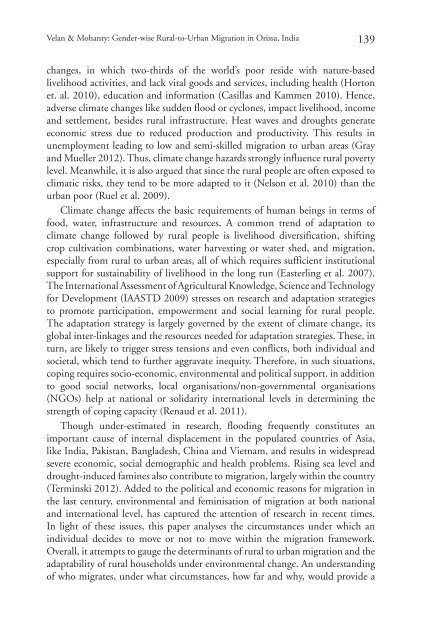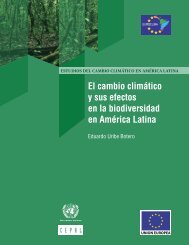Inequality and Climate Change Inégalité et changement climatique
Inequality
Inequality
Create successful ePaper yourself
Turn your PDF publications into a flip-book with our unique Google optimized e-Paper software.
Velan & Mohanty: Gender-wise Rural-to-Urban Migration in Orissa, India 139<br />
changes, in which two-thirds of the world’s poor reside with nature-based<br />
livelihood activities, <strong>and</strong> lack vital goods <strong>and</strong> services, including health (Horton<br />
<strong>et</strong>. al. 2010), education <strong>and</strong> information (Casillas <strong>and</strong> Kammen 2010). Hence,<br />
adverse climate changes like sudden flood or cyclones, impact livelihood, income<br />
<strong>and</strong> s<strong>et</strong>tlement, besides rural infrastructure. Heat waves <strong>and</strong> droughts generate<br />
economic stress due to reduced production <strong>and</strong> productivity. This results in<br />
unemployment leading to low <strong>and</strong> semi-skilled migration to urban areas (Gray<br />
<strong>and</strong> Mueller 2012). Thus, climate change hazards strongly influence rural poverty<br />
level. Meanwhile, it is also argued that since the rural people are often exposed to<br />
climatic risks, they tend to be more adapted to it (Nelson <strong>et</strong> al. 2010) than the<br />
urban poor (Ruel <strong>et</strong> al. 2009).<br />
<strong>Climate</strong> change affects the basic requirements of human beings in terms of<br />
food, water, infrastructure <strong>and</strong> resources. A common trend of adaptation to<br />
climate change followed by rural people is livelihood diversification, shifting<br />
crop cultivation combinations, water harvesting or water shed, <strong>and</strong> migration,<br />
especially from rural to urban areas, all of which requires sufficient institutional<br />
support for sustainability of livelihood in the long run (Easterling <strong>et</strong> al. 2007).<br />
The International Assessment of Agricultural Knowledge, Science <strong>and</strong> Technology<br />
for Development (IAASTD 2009) stresses on research <strong>and</strong> adaptation strategies<br />
to promote participation, empowerment <strong>and</strong> social learning for rural people.<br />
The adaptation strategy is largely governed by the extent of climate change, its<br />
global inter-linkages <strong>and</strong> the resources needed for adaptation strategies. These, in<br />
turn, are likely to trigger stress tensions <strong>and</strong> even conflicts, both individual <strong>and</strong><br />
soci<strong>et</strong>al, which tend to further aggravate inequity. Therefore, in such situations,<br />
coping requires socio-economic, environmental <strong>and</strong> political support. in addition<br />
to good social n<strong>et</strong>works, local organisations/non-governmental organisations<br />
(NGOs) help at national or solidarity international levels in d<strong>et</strong>ermining the<br />
strength of coping capacity (Renaud <strong>et</strong> al. 2011).<br />
Though under-estimated in research, flooding frequently constitutes an<br />
important cause of internal displacement in the populated countries of Asia,<br />
like India, Pakistan, Bangladesh, China <strong>and</strong> Vi<strong>et</strong>nam, <strong>and</strong> results in widespread<br />
severe economic, social demographic <strong>and</strong> health problems. Rising sea level <strong>and</strong><br />
drought-induced famines also contribute to migration, largely within the country<br />
(Terminski 2012). Added to the political <strong>and</strong> economic reasons for migration in<br />
the last century, environmental <strong>and</strong> feminisation of migration at both national<br />
<strong>and</strong> international level, has captured the attention of research in recent times.<br />
In light of these issues, this paper analyses the circumstances under which an<br />
individual decides to move or not to move within the migration framework.<br />
Overall, it attempts to gauge the d<strong>et</strong>erminants of rural to urban migration <strong>and</strong> the<br />
adaptability of rural households under environmental change. An underst<strong>and</strong>ing<br />
of who migrates, under what circumstances, how far <strong>and</strong> why, would provide a





